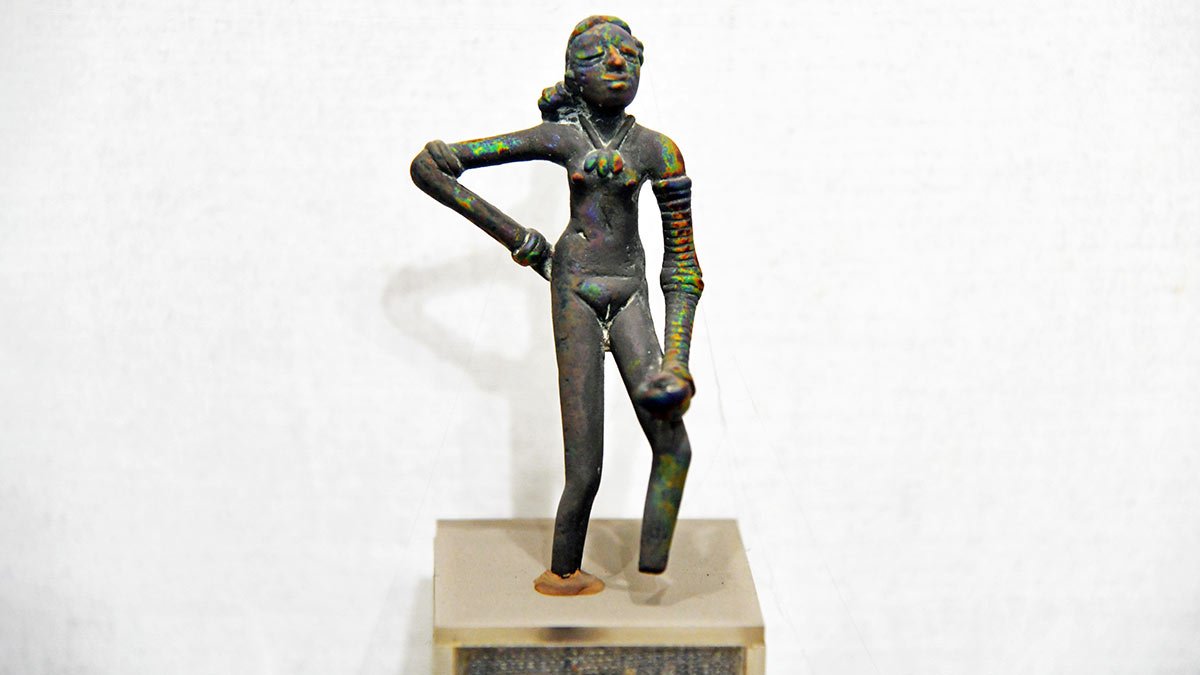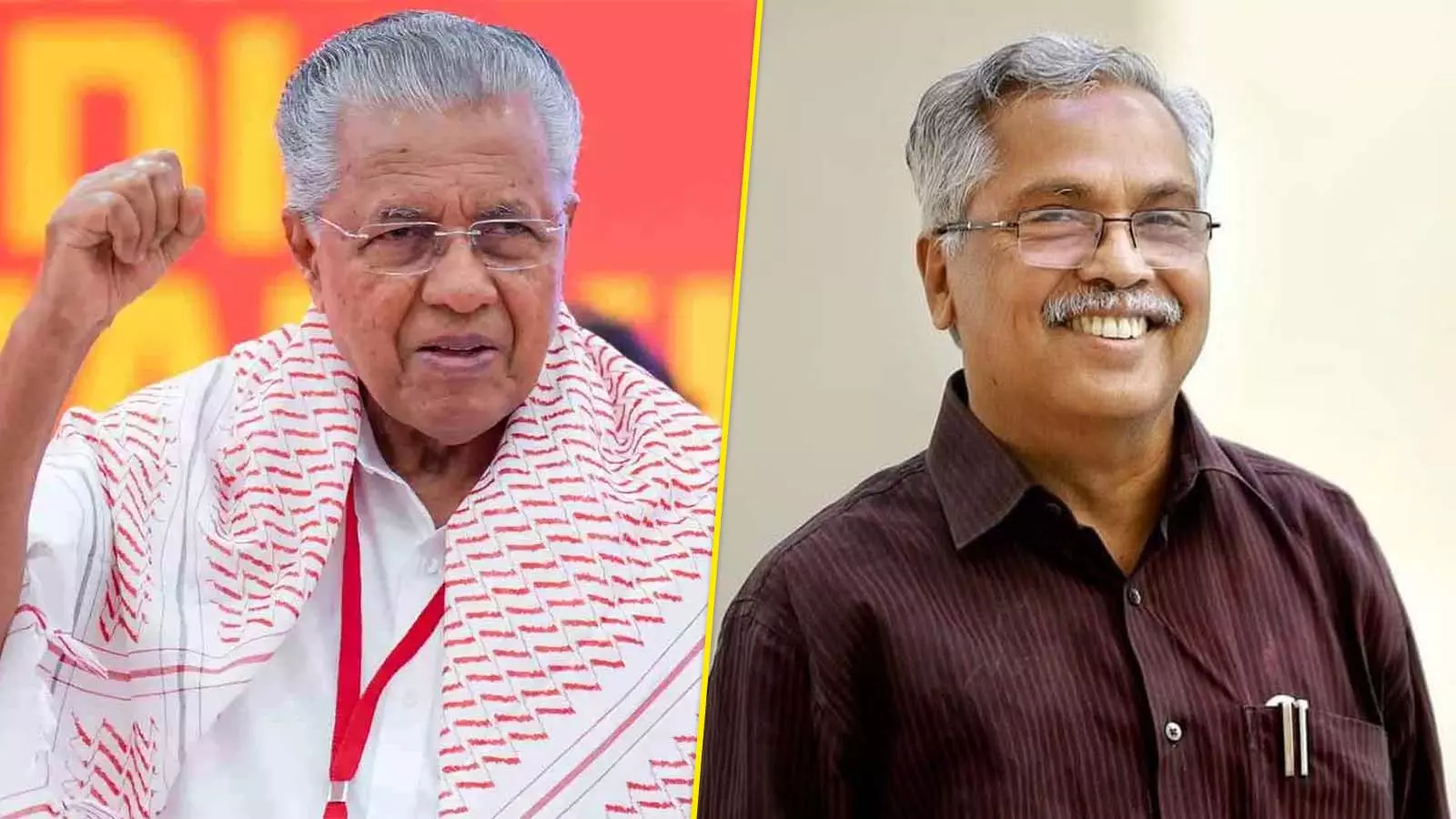Why in the News?
- A replica of the Mohenjodaro ‘Dancing Girl’ was recently stolen and recovered from the National Museum, Delhi, raising concerns about security in cultural institutions.
- The incident involved a university professor, highlighting the need for ethical conduct during educational visits and responsibility towards national heritage.
- It underscores the importance of protection of cultural artifacts, both originals and replicas, to preserve India’s historical and archaeological legacy.
About the Dancing Girl Statue
- The ‘Dancing Girl’ is a bronze sculpture from the Indus Valley Civilization, dating back to circa 2500 BCE.
- Dimensions: 5 cm in height, 5 cm in width, and 2.5 cm in depth.
- The statue reflects the high artistic skill of Mohenjodaro artisans and is named for its dynamic posture: right hand on the back of the hip, left hand on the left thigh.
- Features include large eyes, curly hair, flat nose, a plaited bun, and ornamentation with a necklace and bangles.
- Notably, the arms are unnaturally long, a stylistic trait of the era.
- Interesting detail: she wears 24 bangles on one arm and 4 on the other, indicating attention to detail in craftsmanship.
- The figure is depicted in a tribhanga pose, with three bends at the knees, waist, and neck, creating a graceful S-shaped curve.
- This posture, also seen in classical Odissi dance, is a recurring motif in ancient Indian art, symbolizing grace and spiritual connection.
About the Lost Wax Technique
- The statue was created using the ‘Lost Wax’ method, an ancient metal casting technique.
- Process:
- A wax model of the sculpture is made.
- The model is covered with clay, leaving small passage holes.
- The clay mould is heated, causing the wax to melt and drain out.
- Once cooled, the clay covering is removed to reveal the solid bronze figure.
- Final finishing touches are applied to the bronze sculpture.
- This technique demonstrates advanced metallurgical knowledge and artistic precision of the Indus Valley Civilization.
About Mohenjo-Daro
- Location and Timeline:
- Mohenjo-Daro, meaning “Mound of the Dead”, is an ancient city of the Indus Valley Civilization, flourishing between 2600-1900 BCE.
- Located in Sindh province, Pakistan, on the banks of the Indus River.
- Discovery and Significance:
- Discovered in 1922 by R. D. Banerji of the Archaeological Survey of India.
- Built around the same time as the Great Pyramids of Egypt.
- Recognized as a UNESCO World Heritage Site in 1980.
- Urban Planning and Infrastructure:
- Laid out in a rectilinear grid pattern using baked bricks.
- Featured a complex water management system: sophisticated drainage, covered sewers, and baths in nearly every house.
- Included a 900-square-foot Great Bath, about 700 wells, and individual household toilets, reflecting advanced civic planning.
- City Structure:
- Citadel (Western Mound):
- Built on a raised platform of mud bricks.
- Contained important administrative and religious structures: Great Bath, granaries, and College of Priests.
- Citadel (Western Mound):
- Fortified with a thick mud-brick retaining wall.
- Lower Town (Eastern Mound):
- Settlement for commoners, also fortified.
- Organized streets and alleys, divided into guild-based sub-sections.
- Rich source of artifacts and burial practices evidence.
- Housing and Social Structure:
- Houses featured a central courtyard surrounded by rooms, with doors and windows opening into alleys.
- Multi-storey houses reflected wealth concentration: commoners had single-storey homes, while the rich lived in double or treble-storey houses.
- Each household had individual bathrooms and toilets, showing emphasis on hygiene and planning.
About Indus Valley Civilization (IVC)
- Overview:
- Earliest known urban culture of northwestern Indian subcontinent (c. 3300-1300 BCE).
- One of the world’s three earliest civilizations, along with Mesopotamia and ancient Egypt.
- Flourished due to fertile plains, moderate climate, and river systems.
- Named after the Indus River, also called Indus-Sarasvati Civilization.
- Origin and Discovery:
- Evolved from irrigated agricultural villages, influenced by Mesopotamia.
- Key discoveries:
- Harappa: first site identified (Charles Masson), excavated by Daya Ram Sahni (1920).
- Mohenjo-Daro: excavated by Rakhaldas Banerjee (1921).
- John Marshall (1924) announced the civilization’s existence.
- Flourished along Indus and Ghaggar-Hakra rivers.
- Chronology and Phases:
- Early Harappan / Regionalization (3300-2600 BCE):
- Sites: Harappa, Kot Diji, Amri
- Fortifications, grid planning, early craft specialization, initial trade networks
- Transitional Phase:
- Sites: Kunal, Dholavira, Harappa
- Increasing craft specialization, organized irrigation, partly standardized pottery
- Mature Harappan / Integration (2600-1800 BCE):
- Sites: Mohenjo-Daro, Harappa, Kalibangan, Dholavira
- Full-scale urbanization, writing system, uniform artefacts, thriving internal and external trade
- Late Harappan / Localization (1800-1300 BCE):
- Sites: Cemetery H, Siswal, Rojdi, Rangpur
- Decline of urban centers, rise of pastoral and rural settlements
- Key Features:
- Urban Planning:
- Cities are divided into Citadel (administrative/religious) and Lower Town (residential).
- Grid-based streets intersecting at right angles.
- Urban Planning:
- Early Harappan / Regionalization (3300-2600 BCE):
- Advanced drainage systems, wells, and bathrooms in houses.
- Housing:
- Houses of burnt bricks, single or multi-storey depending on wealth.
- Central courtyard, doors/windows opening to alleys.
- Other Structures:
- Great Bath and Pillared Hall at Mohenjo-Daro
- Dockyard at Lothal, granaries at Harappa
- Economy:
- Agriculture: Wheat, barley, peas, rice; dependent on flood irrigation.
- Animal domestication: Goats, buffaloes, oxen, camels, dogs, elephants (no horse).
- Metallurgy: Copper, gold, silver; weapons, tools, ornaments, metal casting.
- Trade: Internal trade and Mesopotamian trade; exported grain, pottery, jewellery; imported copper, precious stones.
- Social Structure:
- Political authority: Evidence from standardized artifacts, communication, trade networks.
- Social classes: Merchants (upper), artisans/farmers (commoners).
- Dress and ornaments: Cotton, wool, jewellery of gold, silver, ivory, precious stones.
- Recreation: Dance, music, dice games; terracotta toys for children.
- Religion:
- Worship of Mother Goddess; Proto-Shiva seal indicates yogic deity worship.
- Possible veneration of pipal trees.
- No temples found; religious practices inferred from figurines and seals.
- Art and Craftsmanship:
- Figurines of bronze, terracotta, steatite, faience.
- Faience: artificial material made from quartz; used for beads, bangles, figurines.
- Pottery: made on a potter’s wheel, painted red and black.
- Crafts: spinning, weaving, brick-making, metalwork.
- Script:
- Indus script: pictorial, undeciphered, often boustrophedon (alternating directions).
- Seals depict plants, animals, and symbolic inscriptions.
- Causes of Decline:
- Climatic changes: gradual aridification rendered the region less hospitable.
- Natural calamities: floods or earthquakes disrupting settlements.
- Decline in trade: rivers Indus and Sarasvati changed courses (~1900 BCE), affecting internal and external trade.
- Led to abandonment of urban centers and rise of pastoral/rural settlements.
Conclusion
The Mohenjodaro ‘Dancing Girl’ exemplifies the artistic brilliance and metallurgical skill of the Indus Valley Civilization. The recent theft highlights the need for better security and ethical responsibility towards cultural heritage. Studying Mohenjodaro and IVC provides critical insights into urban planning, social organization, economy, art, and religion of one of the world’s earliest civilizations.
| Ensure IAS Mains Question Q. Examine the significance of the Mohenjodaro ‘Dancing Girl’ and related Indus Valley artifacts in understanding the urban planning, social structure, and technological advancements of the Indus Valley Civilization. (250 words) |
| Ensure IAS Prelims Question Q. Consider the following statements regarding the Mohenjodaro ‘Dancing Girl’ sculpture: 1. It is a bronze figurine dating back to circa 2500 BCE. 2. The sculpture depicts the woman in a tribhanga pose, with three bends at the knees, waist, and neck. 3. It was made using the Lost Wax technique. Which of the statements given above is/are correct? a) 1 and 2 only b) 1, 2, and 3 only c) 2 and 3 only d) 1 and 3 only Answer: b) 1, 2, and 3 only Explanation: Statement 1 is correct: The Mohenjodaro ‘Dancing Girl’ is a bronze figurine dating to circa 2500 BCE, making it one of the earliest known metal sculptures in the Indian subcontinent. This sculpture reflects the high degree of craftsmanship of the artisans of the Indus Valley Civilization, showcasing their proficiency in metallurgy and fine artistic detailing. The figure’s small size, precise features, and realistic posture provide valuable insights into the cultural, aesthetic, and technological sophistication of the era, indicating a society capable of creating intricate art for aesthetic and possibly ritual purposes. Statement 2 is correct: The sculpture depicts the woman in a tribhanga pose, which involves three bends in the body at the knees, waist, and neck, creating a graceful S-shaped curve. This posture demonstrates the Indus artisans’ understanding of human anatomy and balance, as well as their ability to convey movement and poise in a small-scale bronze figure. The tribhanga pose is also a recurring motif in classical Indian dance, reflecting continuity in artistic expression across centuries, and highlights the civilization’s emphasis on aesthetics, grace, and symbolic representation in their art. Statement 3 is correct: The ‘Dancing Girl’ was created using the Lost Wax technique, an ancient metallurgical process where a wax model is first made and then encased in clay. When heated, the wax melts away, leaving a cavity that is filled with molten bronze. This method demonstrates the Indus Valley Civilization’s advanced knowledge of metal casting and their ability to produce precise and durable sculptures. The use of this sophisticated technique indicates both technological innovation and the high value placed on artistic expression, showing a society with a combination of craftsmanship, science, and aesthetic vision. |
Also Read | |
| UPSC Foundation Course | UPSC Daily Current Affairs |
| UPSC Monthly Magazine | CSAT Foundation Course |
| Free MCQs for UPSC Prelims | UPSC Test Series |
| ENSURE IAS NOTES | Our Booklist |





